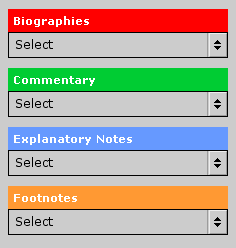The seminal 1964 article, "Harold Adams Innis and Marshall McLuhan" by James Carey has been annotated with commentary, dictionary definitions, primary source material from the works of Innis and McLuhan, and a video interview from 2002 with Professor Carey himself.
![]()
Behind the universal sign for information, are notes that deal with a subtext of a particular paragraph, essentially allowing for commentary on a whole paragraph without underlining the entire text of the paragraph as a link. Often behind the paragraph gloss will be primary sources and video relevant to material from the specific paragraph you were reading.
Underlined and colored words in Carey's article are linked to annotations which are to be read in the left hand window.
Biographies - includes both information or biographies of fictional characters and historical figures
Commentary - original annotation material for more complex concepts which might be contentious notions in the field of communications research.
Explanatory Notes - to explain unfamiliar concepts using adaptations from respectable encyclopedias
Footnotes - marked with an asterisk (*).

The textual definitions in the smaller annotation window may also have sub- pages offering multimedia such as video, text excerpts from Innis and Mcluhan, relevant websites for further research, and offline resources for further reading.
| note | < |
- the textual annotation |
||
| resources | < |
- pertinent web sites and offline resources for further reading |
||
| media | < |
- including video and textual excerpts from Innis' and McLuhan's works |
||
| keywords | < |
- links to annotations associated with the current annotation |
![]()
McLuhan's Work, Innis's Work
Provides the user with the non-contextual index of primary sources for further reading. These are presented as excerpts with all bibliographical and source material noted, although they are themselves not annotated. A list of reading materials for offline viewing is also included.
Interactive Outline
Read the outline as a guide to the basic argument that Professor Carey provides in his article. Links are available to terms which are annotated and links are available to the paragraph of the article which is under examination. Clicking on these links will move the webpage below the popped-up outline. This is another point of access to the material.
Interview
This buttons pops up an instance of real's free player with 30 or so clips available from a two hour interview with James Carey hosted by Frank Moretti in the summer of 2002. If you do not have Real you must download it here.
"Go" Feature
This function allows you to autoscroll the spine text to any paragraph you enter into the input field. After you type in your paragraphs (numbered from 1-94) click "Go".
If you come to an annotation from another annotation, this function will allow you to autoscroll the spine text to any paragraph in which the annotation appears.


Start the MSE
This button enables the user begin using the Multimedia Study Environment.
Back to Prologue
This is a button to return you to the homepage of the site where are available pages for technical help, for acknowledgements, as well as teacher's guides on how to integrate the website into a course curriculum.
Help
This page.
For IBM-Compatible PC
For Macintosh